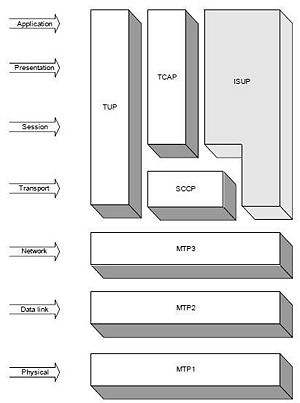ISUP
The ISDN User Part (ISUP) is the highest layer in the SS7 signaling stack and is responsible for the handling of calls.
The ISUP layer offers virtual control over ‘circuits’ (which are really TDM timeslots) and the ability to associate calls with them. ‘Circuits’ conveying the end-to-end voice conversation are truly separated from the signaling links that MTP1-MTP3 are transmitting onto. This allows an SS7 end-point to control equipment not even located at the same facility. Once the virtual call is established, the application interfacing with the ISUP layer is responsible for sending appropriate commands to the systems to actually connect the voice path.
ISUP is responsible for negotiating the call parameters and also negotiating with other SS7 nodes within the network the path through which TDM voice data will be connected. (ISUP is responsible for negotiating circuit assignment/reservation. It does not actually open the TDM channels to connect the physical timeslots.)
A schematic of ISUP in the OSI model is provided by the first image on the right. The next image provides a conceptual illustration of the ISUP protocol layer as implemented by TelcoBridges.
Contents |
Features
The ISUP protocol layer supports for following features:
- Multi-rate connection establishment, circuit maintenance, connection release, and abnormal conditions for multi-rate calls. Multi-rate connections are circuit switched connections requiring more than one bearer channel. This feature is part of the ANSI 95, ITU 97, and ETSI v3 specifications
- Operation in a decomposed media network. ISUP supports multiple variant and SS7 networks within the same stack
- Recovery of lost primitives crossing the upper, lower, and layer management interfaces
- Configurable call validation testing behavior during MTP3 Resume primitive for the ANSI 95 variant
- En bloc and overlap signaling
- International and national capabilities
- Link-by-link signaling using the pass-along method
- Each link may be configured to support a variant independent of any other link. For example, one link may support ITU 1988 while another link supports ANSI 1992
- Supplementary services, including user access to calling party address id, user access to called party address id, user-to-user signaling, and call forwarding
- Local Number Portability (LNP) for ANSI and Telcordia (formerly Bellcore)
- Multiple Originating Point Codes (OPCs)
- Message compatibility, parameter compatibility, and wrong parameter values procedures
- Circuit management procedures including blocking, unblocking, and reset
- Circuit group management procedures including blocking, unblocking, reset, and query
- Message segmentation procedures for ITU and ETSI variants
- Configurable call clearing behavior for MTP Level 3 Pause/Resume priorities
- Passing proprietary parameters transparent between upper and lower layers
TelcoBridges and ISUP
TelcoBridges supports ISUP as part of its SS7 signaling stack implementation. It also offers the following functionality:
- Control of up to 30,000 CICs per system

